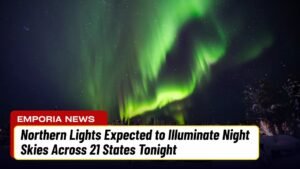On the evening of November 10, 1915, multiple tornadoes struck Kansas, with the worst damage in and around Great Bend and the Zyba–Derby area near Wichita. At least three tornadoes formed, two of them violent F4s, leaving a combined death toll of about 15 and dozens injured.
Homes, farms, mills and rail facilities were levelled in their tracks.
The Great Bend F4: the deadliest track
The first violent tornado carved a path of roughly 35 miles, about 300 yards wide, clipping the southeast side of Great Bend. It destroyed approximately 160 homes, killed 11 people, and injured about 75, with losses estimated near $1 million (in 1915 dollars).
Livestock losses were massive: around 1,000 sheep alone were lost in nearby pastures. Debris from town was carried up to 85 miles, and witnesses reported dead ducks falling from the sky near Claflin—a haunting sign of the storm’s power.
Another F4 near Zyba–Derby
Farther south in south-central Kansas, a second F4 tornado struck near Zyba and Derby, causing 4 additional deaths and extensive structural damage along its corridor. With Great Bend’s toll, the statewide fatalities reached around 15 that night.
Flying paper, far-flung debris
Researchers later documented that paper debris from the Great Bend storm travelled extraordinary distances.
One famous example: a cancelled check carried roughly 210 miles and found in Palmyra, Nebraska, illustrating how a tornadic thunderstorm can loft lightweight material far beyond the damage path.
Key facts at a glance
| Detail / Metric | Great Bend, KS (F4) | Zyba–Derby, KS (F4) | Notes |
|---|---|---|---|
| Date & time | Nov 10 1915 (evening) | Nov 10 1915 (evening) | Same synoptic system |
| Path length | ~35 miles | Not precisely documented | Great Bend path well recorded |
| Approx. width | ~300 yards | — | Width varies along path |
| Fatalities | 11 | 4 | ~15 statewide total |
| Injuries | ~75 | Not specified | Injuries likely higher statewide |
| Homes destroyed | ~160 | Many damaged/destroyed | Great Bend count specific |
| Damage (1915 $) | ~$1,000,000 | — | Great Bend estimate |
| Livestock losses | ~1,000 sheep | — | Great Bend environs |
| Debris travel | ~85 miles (general); ~210 miles (paper) | — | Ducks fell near Claflin; check found in Nebraska |
What made Nov 10 1915 so dangerous?
- Late-season risk: While spring is the peak time for tornadoes in the Great Plains, sharp November cold fronts colliding with lingering warm, moist air can still spawn violent supercells, as 1915 proved.
- Limited warnings: In 1915, there was no modern radar, sirens or real-time communication, so communities had little to no lead time. Contemporary accounts emphasise the suddenness and the fact it happened at night—a worst-case scenario for casualties.
- Long-track supercell: The Great Bend storm’s track length and intensity allowed it to impact multiple neighbourhoods and industrial sites, including mills and rail yards, amplifying losses.
Remembering and learning, 110 years on
Today, Doppler radar, storm-spotter networks, wireless alerts, and reinforced construction help reduce casualties. Still, the 1915 outbreak is a stark reminder that autumn tornadoes in Kansas can be violent, and preparedness—from safe rooms to family plans—remains essential.
The Nov 10, 1915 Kansas tornado outbreak remains one of the state’s most devastating late-season events. With two F4 tornadoes, a ~35-mile Great Bend track, $1 million in losses, and ~15 lives lost, it stands as a solemn anniversary.
A century later, the lesson is clear: Kansas’ tornado risk doesn’t end with spring, and ongoing preparedness, resilient building, and timely warnings are the best way to honour those affected and protect communities today.




